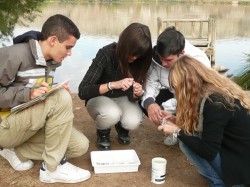When you wake up in the morning and start your daily routine—take a shower, brush your teeth, cook breakfast—do you ever stop to wonder where all that water you’re using comes from? It’s availability (or lack thereof) is certainly not a common worry in the United States, where as of 2005 (the latest assessment of national water use conducted by the U.S. Geological Survey) about 86 percent of the population relies on public water supplies for household use. Turn a faucet handle, and water, the world’s most precious, life-giving resource, is simply there, ready to cool us or clean us or quench us of our thirst, wherever we need it, whenever we want it.

But for how much longer? Climate change, pollution and unprecedented global demand are already threatening the world’s water supply according to a United Nations World Water Development Report released earlier this year. (SciStarter partnered with Discover Magazine, the National Science Foundation and NBC Learn to explore the Future of Water as part of our Changing Planet series.)
In response to these challenges, two international nonprofit organizations, the Water Environment Federation (WEF) and the International Water Association (IWA), partnered up to launch a challenge of their own.
Today, September 18, is World Water Monitoring Day, a key component of the broader World Water Monitoring Challenge that runs from March 22 to December 31. Thousands of people from around the world will use low cost monitoring kits to test their local water bodies for the basic indicators of watershed health–temperature, acidity, turbidity, and dissolved oxygen—and enter their results into a shared online database. It’s not too late to get involved. The program’s administrators hope that participants will not only learn which rivers, lakes, streams and reservoirs supply their communities but also become aware of the unique combination of environmental challenges each one faces.

“These are issues the next generation will have to cope with,” said Lorien Walsh of the Water Environment Federation. “The water we drink today is the same water people have been drinking for thousands of years. It is a finite resource, and we can’t use it if it’s not clean.”
In 2011, over 300,000 people from nearly 80 countries participated in the World Water Monitoring Challenge. Taking clean water for granted might be common in the United States, but it is a luxury people can ill afford in the developing world, where three million people, most of them women and children, die from water-borne illnesses like cholera every year.
“Kids in Kansas can see the data they collected and compare it to the data collected by kids in the Congo,” said Walsh. “There’s a stark difference.”
